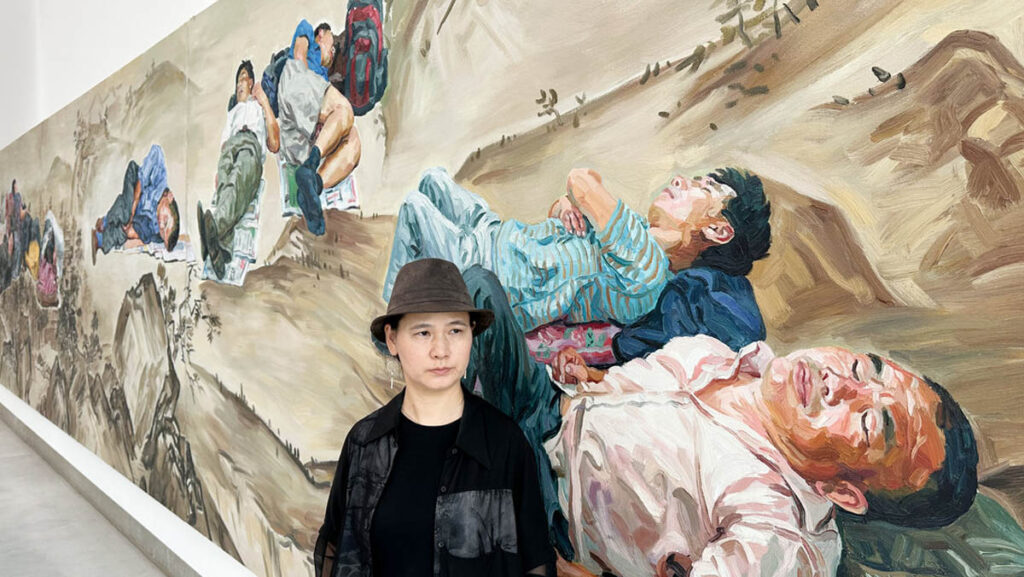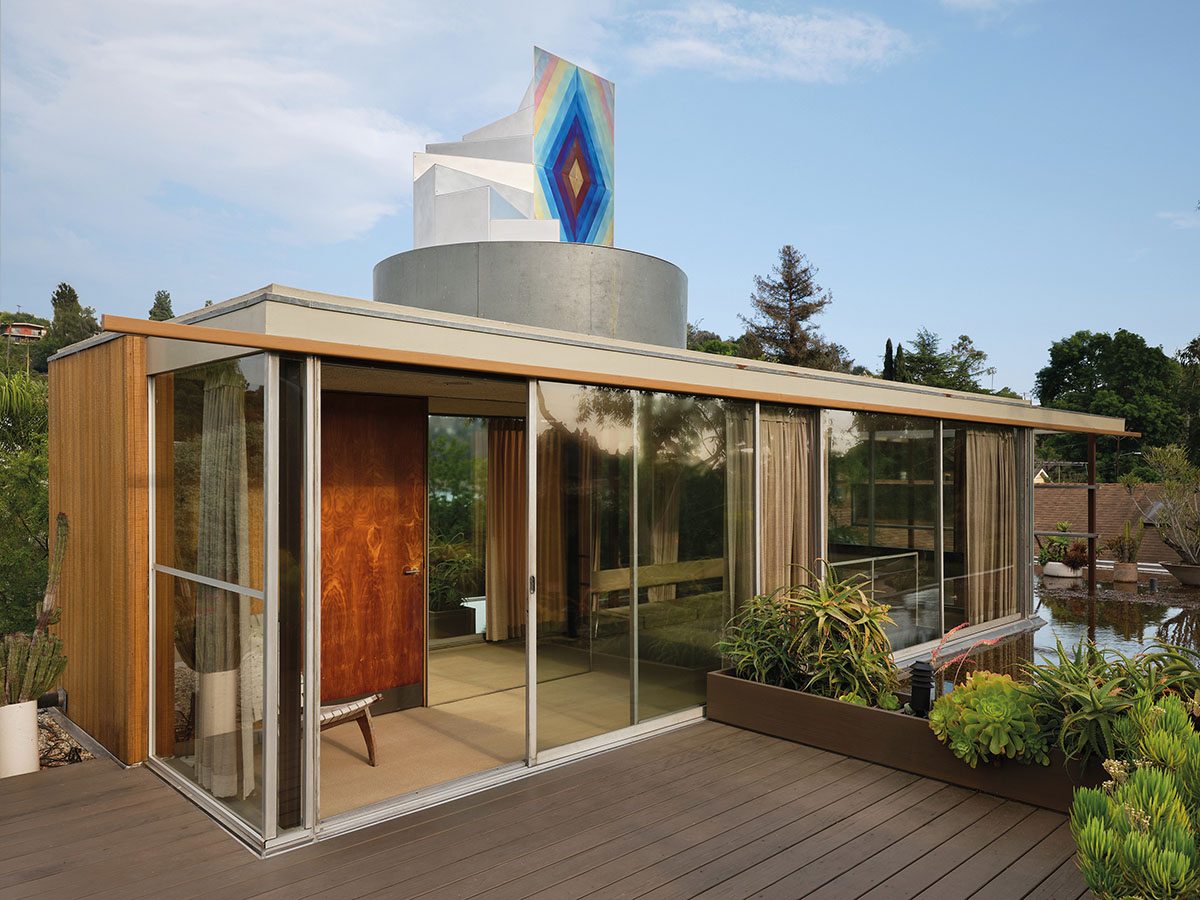
Where are you these days – in the world, and your work?
These days, I’m lucky to be staying at the historic VDL Research House in Los Angeles, California, where I’ve just finished installing my site-specific exhibition Game of Goose, curated by Dan Handel.
The VDL House is an esteemed National Historic Landmark designed by Austrian-American architect Richard Neutra. It used to be his home and studio, and it served as a sort of case study house. Neutra also called it the Research House, as it was a place for experimentation, where he could test ideas and demonstrate the essence of his practice.
What parts of your experience in Los Angeles have found their way into your studio practice?
Richard Neutra was deeply interested in how the built environment can affect mental experience. In a way, the VDL House transforms architecture into metaphor: as a glass house with nearly 20 doors, it blurs the boundaries between interior and exterior like a body with porous skin. The interior symbolizes the mind or inner self, while the exterior reflects the outside world (which constantly bleeds inward).
Another bold feature of this space is reflections, they are everywhere. On every level there is a reflecting water pool, the glass is reflective, and there are actual mirrors on the walls and ceiling in unexpected places. You are always aware of yourself and constantly “meeting” yourself. Again, the physical reflection appears as a metaphor for reflection in the sense of contemplation or introspection.
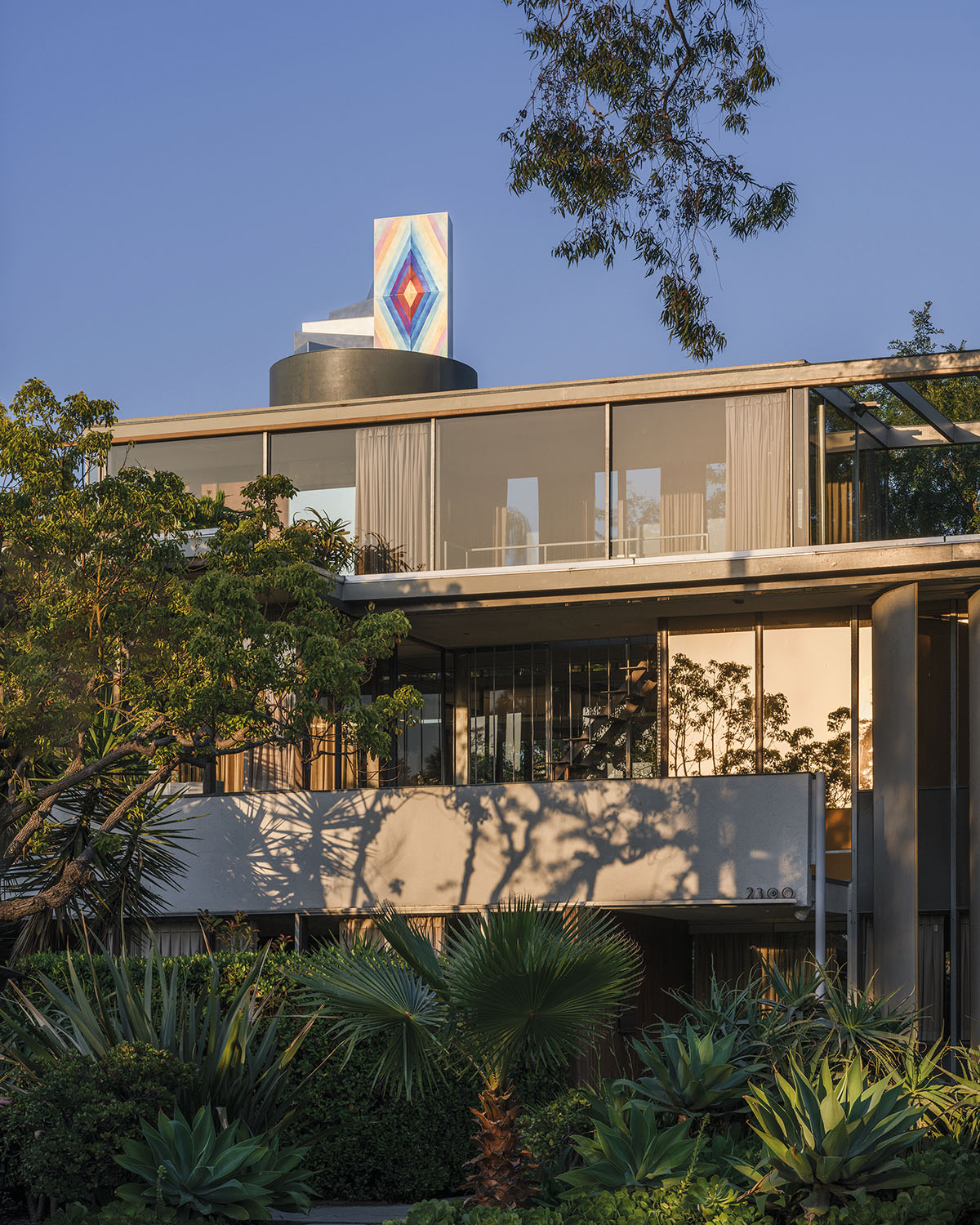
As a child, I grew up in a broken family. Neither of my parents was truly present, my father literally left, and my mother sank into a deep depression. School was rife with violence, and the “outside world” felt chaotic, vulgar, and catastrophic. For my spirit, it was simply too much to handle. I felt the need to shield myself from my surroundings, though physically, I lived in the attic of our house, situated above the living room like a kind of terrace. It had two facades that were completely open, with only safety railings – no walls, no door I could close.
As an act of survival, I transformed this space into my shrine. I had a collection of objects that I was constantly organizing and cleaning, carefully creating the right physical conditions for each piece. Most of the time, I simply contemplated and appreciated these objects. It wasn’t anything fancy or expensive, just simple objects in which I found something special and precious: an energy that came from the attention, skill, and care someone had put into making them. It was something my soul deeply longed for. Over time, this physical environment became entirely metaphorical, it transformed into a mental space.
Many years later, as an artist, I realized that this childhood room, this attic, had become my studio.
In a way, the VDL House sent me back, or more precisely, deep into the essence of my practice. It allowed me to further explore these elusive relations between the physical environment and mental experience, and how something that might feel familiar or resemble a functional object at first sight can suddenly make you aware of your experience when you realize it’s not what you thought it was. Then the experience becomes more abstract, shifts into the mental realm, and has the potential to reveal more and more layers. This logic drives the works in the exhibition, as they emerge from specific moments in the space.
How did the project come about? How did your involvement with the VDL House begin?
The project was first initiated by Dan Handel, a curator and author whose primary field is architecture, though his work spans across disciplines. Dan introduced my work to VDL director Noam Saragosti, who invited both of us, in the summer of 2023, to spend two weeks at the house in order to develop the proposal for the show. We learned a lot from our conversations with Noam and from countless meetings with Neutra experts, but most importantly, from experiencing what it means to live here.
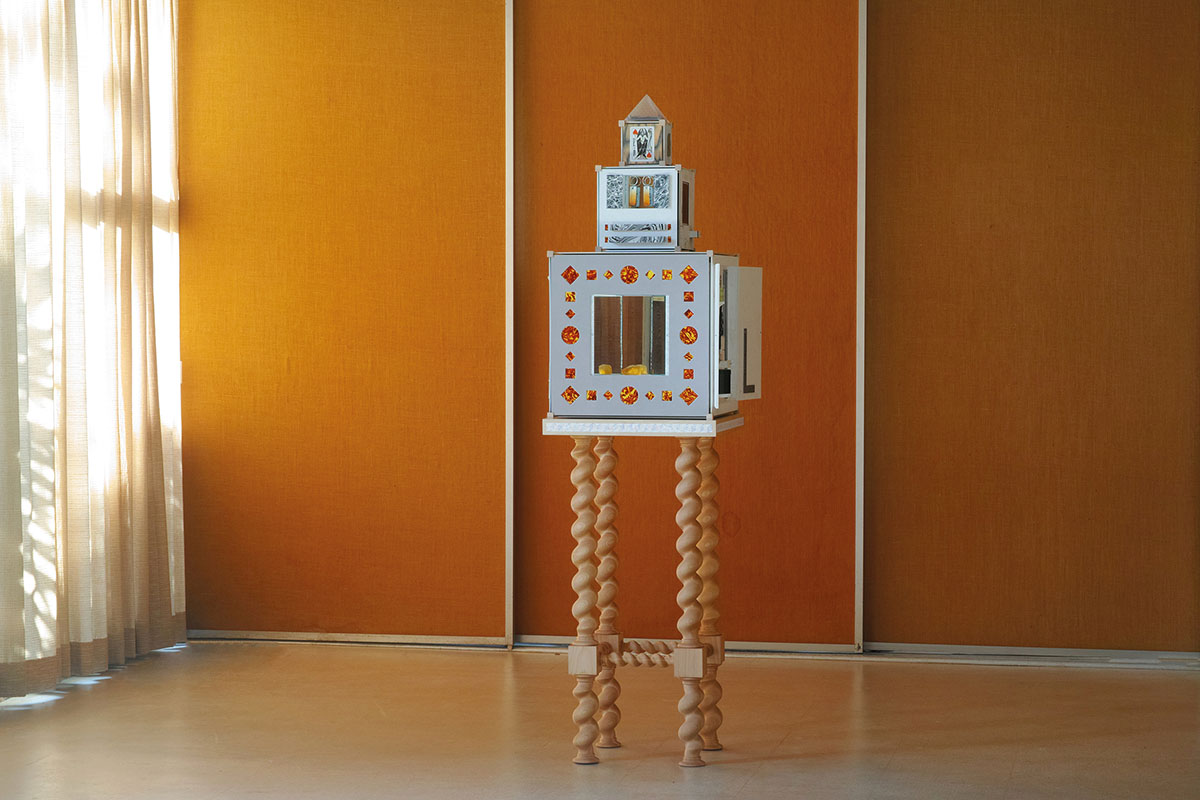
Game of Goose unfolds in a space loaded with architectural history. How did the site shape the way you approached this exhibition?
I would love to give you a virtual tour of the house and the exhibition-
The entrance floor used to be Neutra’s studio, and today it is where visitors can learn about his practice and about the VDL House, before they start their tour. So there are books about or by Neutra, original drawings and architectural models of the house, historical pictures, etc. We’ve decided to leave this space clean (or “empty”) and place a single work in its center. It is titled Tool Chest, though it resembles a cabinet of curiosities (Wunderkammer). This piece serves as both an introduction to the exhibition and a microcosm of the house itself. It is composed of three levels, like the VDL House, and functions as an abstraction of the human body. The idea of the exterior as “the outside world” and the interior as the inner self led me to think of the body as a space, and the house as a living being.
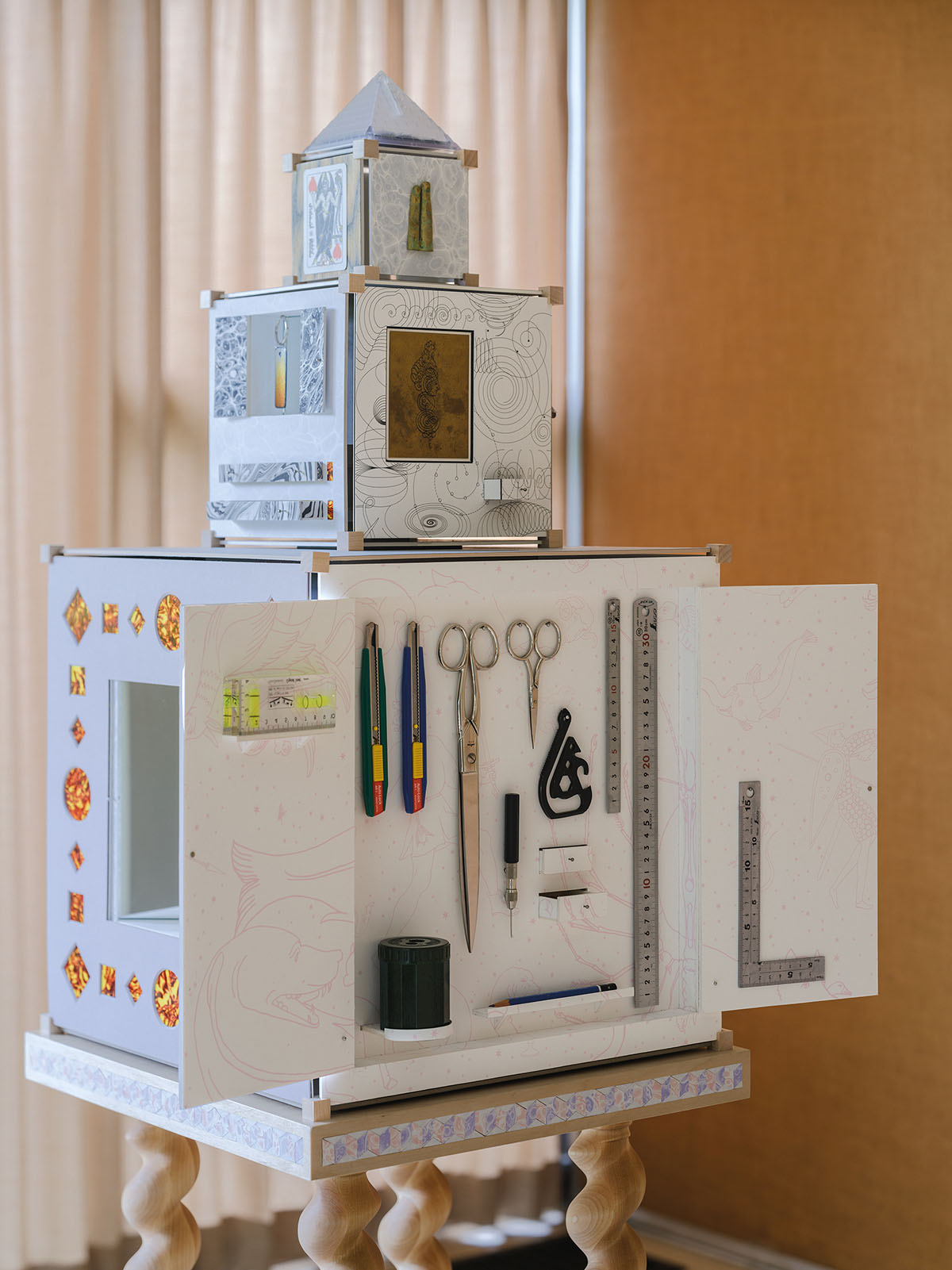
All these drawers, doors, and windows open to reveal “my world” to the viewer: experiments in material, samples, and sketches of works that appear later in the exhibition. On one of the facades, you can see pictures of blood spots on my skin and the pendant and necklace I’m currently wearing, which I designed as an additional “blood spot” on my chest. Both the red coral and blood spots form in similar ways: beneath the surface – whether under the skin or underwater – they exist in a liquid or more flexible state. When exposed to air, they solidify, the blood becomes round and stable on the skin, and the coral, also known as Blood Coral, hardens and stabilizes into this gemstone-like material.
Every detail here carries multiple layers of meaning. It reflects the idea of the piece as an abstraction of the body, and also speaks to shifting states and the interplay between interior and exterior.
On another facade, you see samples of marbled papers, or Ebru, a traditional craft I use in my work. It originated in the Islamic world in the 15th century and was used to create intricate patterns for book endpapers, as well as for official documents to prevent forgery, since it’s impossible to recreate the exact same image twice. I work with liquid pigments on a liquid surface, then lay a sheet of paper onto it to absorb the image. It requires a single, continuous movement and a strong sense of flow to get it “right”. Even the slightest shift in rhythm or a passing thought can leave a trace in the pattern. Marblers call these glitches “hesitation marks” something you’d usually leave behind in the studio. Here, I chose to show a collection of my hesitation marks.
There are also actual tools here
These are the actual tools I used to make this work. They’re here to emphasize the tension between two poles: the functional, constructed, geometric, and concrete forms – and the more abstract, fluid, mental states. This tension is also reflected in the dynamic between the cabinet’s rigid structure and its spiraling lower part, as if the concrete object is “melting” into another state, like someone falling in love and their legs turning to spaghetti.
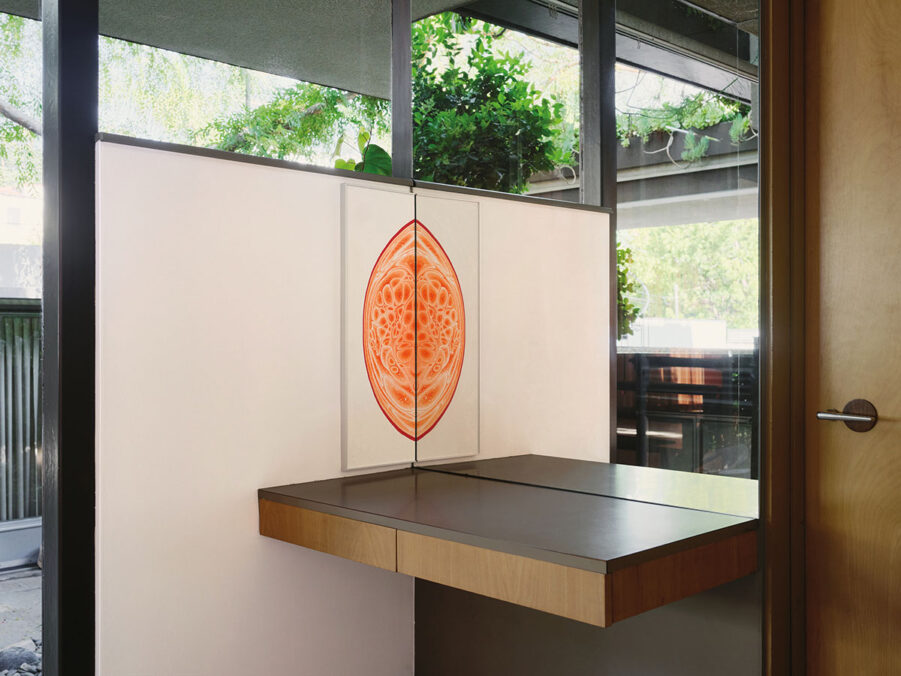
The next work, Bookmatch #2, , is located in the ground-floor study. Marbling, or marbled paper, is named so due to the similarity the patterns might bear to sections of marble or other stones. This led me to think of the craft of bookmatching – slicing and adjoining two surfaces of marble or wood so that they mirror each other and form an almost symmetrical image. In my work, it is a half work, in a half frame, completed through its reflection in a mirror.
Throughout the house, there are many moments like that, where you’re not sure whether you’re looking at a window or a mirror, a material surface or its reflection. The marbled pattern also offers, again, a glimpse into a fluid, cellular interior, something between the inside of a body and the intricate depth of stone.
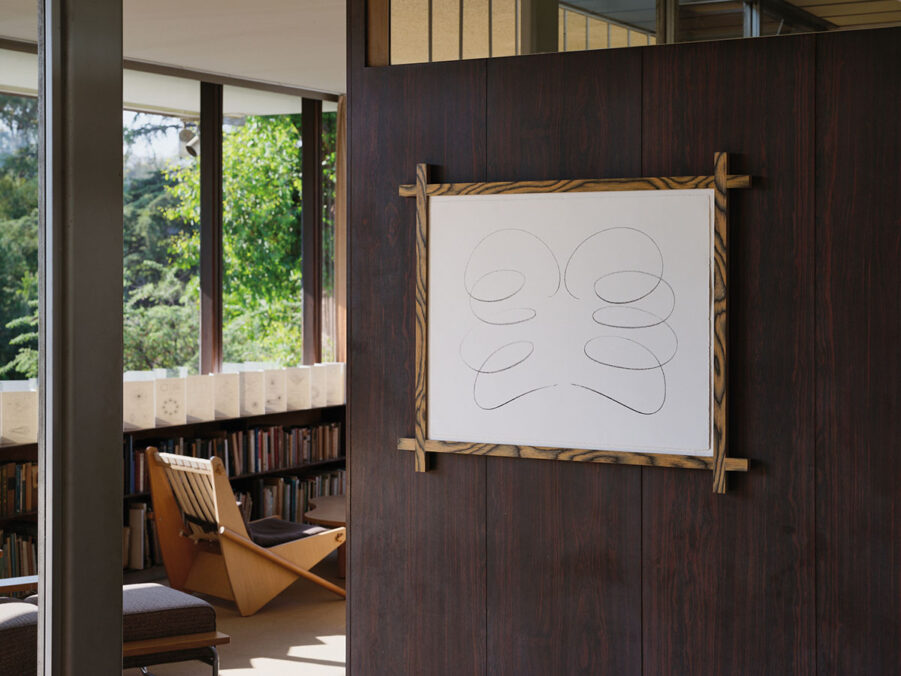
When you walk up the stairs, the landing wall appears unusually close, as if asking you to choose: to turn right into the private living quarters or left into the more public area, where the living room is. Mounted on this wall is Both Hands, a print based on a drawing I made simultaneously with both hands. It embodies the effort to achieve symmetry and resembles a ribcage in its form and structure. The frame is made of plywood and veneer, like all surfaces are treated in the house, simple flat boards covered with thin sheets of another material.
The open corners of the frame echo Neutra’s architectural details; in this house, horizontal and vertical lines never fully close a corner—they always continue. My reading of this is that, once again, he’s saying that separate spheres always bleed into one another. There is no concrete border.
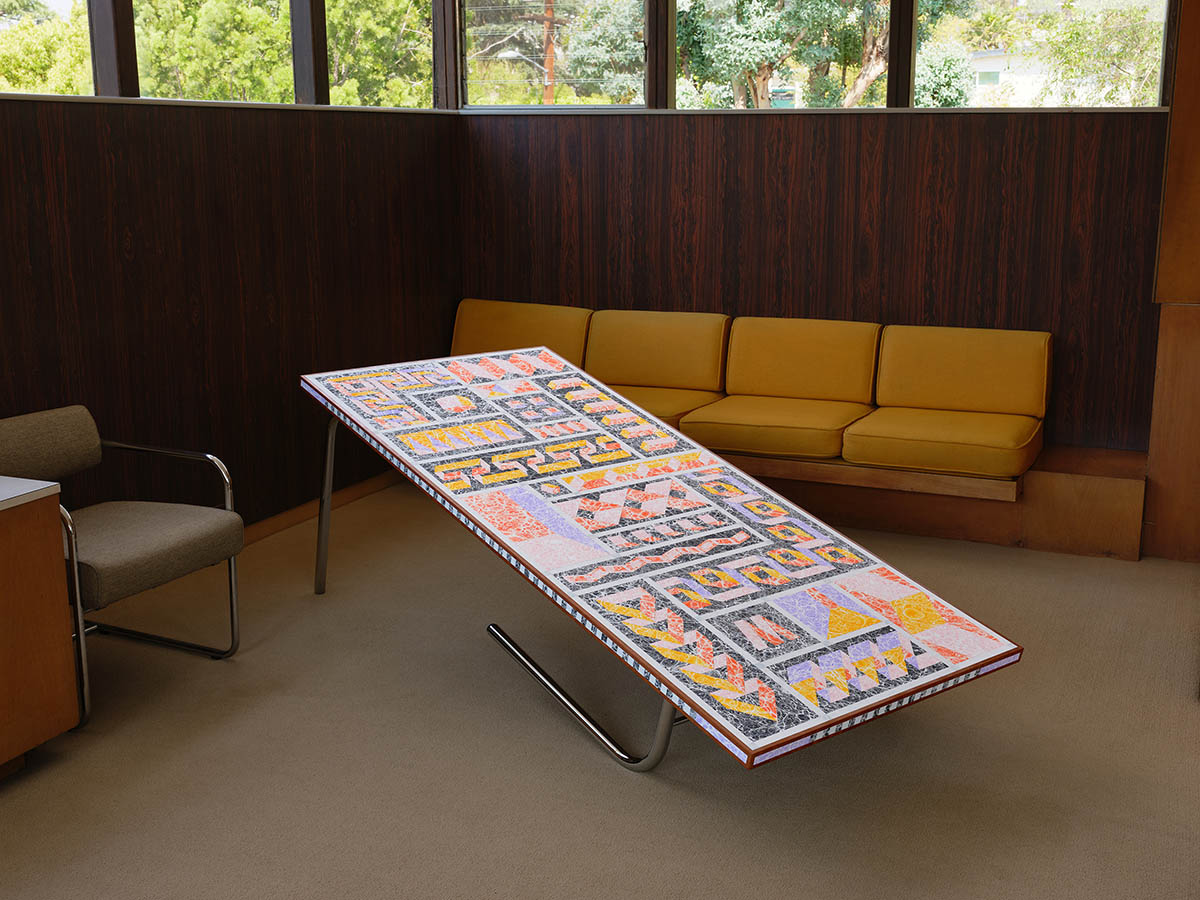
When you enter the living room, you see the Camel Table (Pietra Dura). It is an intervention in Neutra’s iconic Camel Table, originally designed to function as both a dining and coffee table, with folding legs to adjust its height. I left it between states. The top surface is made from many pieces of marbled paper mounted on museum board, then cut and inlaid to form different patterns. All patterns are visual representations of three-dimensional spaces rendered in two-dimensional form. The composition recalls historical pattern books, which architects once used to guide stylistic decisions before the rise of modernism.

On top of the library is Book of Spirals, a sculptural book constructed in an accordion format with two ceramic covers on either side that also function as bookends. Each cover features two inlaid seashells resembling closed eyelids. The book contains 88 pages filled with spiral drawings made using a mechanical drawing device with a robotic arm holding a Rapidograph fineliner pen – commonly used in architectural drafting. The two-faced Janus-like head opens up to reveal the spiraling inner workings of the mind.
This work began with the curtains. They are usually closed when the sun comes from the west in the afternoon, casting a zigzagging or wavy line of light and shadow across the top surface of the library. Now that the work is installed here, during the afternoon hours the pages reflect onto the windows, allowing you to see both sides of the book – one side as the actual object, while the other side appears as a ghostly reflection in the glass.

The living room opens to an outdoor sitting area with a small reflecting pool. At its center is Seashell Sphere, a casting of seashells and plaster, positioned on a glazed ceramic base.
This work began with a desire to recreate natural consolidations of shells and earth I encountered on the shoreline. A seashell is made of merged layers of matter, and its logic extends to broader scales when the layered shell itself becomes a small grain within a larger object, a rock.
During the development of this work, I came across a photo of a ceramic object with a type of glaze that reminded me of the seashell’s external surface. I traced its origins and discovered it was made in a family-run studio called Mazzotti in Albisola, Italy. In the 1930s, they initiated a collection of what they called “futurist objects”. They invited Italian Futurist artists to send their designs for functional objects, which they then produced in the studio. For this series, they developed this specific glaze that provided a recognizable signature for the collection. Surprisingly, I found out the studio is still active, now run by the fourth generation. I contacted them and asked if they would be willing to use this historical glaze to create the base for my work, and they agreed. So that’s how it was made.
The Futurist artists were interested in the idea of stored movement within static forms, another resonance with my work, which refers to the potter’s wheel and, more broadly, to the logic of circular movement, where matter gathers toward a center and curls into a sphere, echoing the formation of celestial bodies.

From the outside terrace, you walk up the stairs to the penthouse floor, a small glass room with built-in furniture that invites you to sit down on the floor. Neutra used to bring people up here and ask them to sit and look at the view through the glass, because from this angle, the reflecting pool surrounding the penthouse would align with the Silver Lake Reservoir. Also, at certain hours of the day, the sun hits the water and reflects onto the ceiling of the room. The movement of light, water, and reflections surrounding you creates a perfect space for contemplation.
The work Rock, positioned here, started with the Zulu textile developed by Giulio Ridolfo for Kvadrat. It’s woven with two different colors for the horizontal and vertical threads; if one is red and the other is blue, the overall color appears purple. But then from one side it looks more blue, and from the other, more red. It’s about the intersection of two colors and two directions that create a kind of magic, an idea that resonates in an interesting way with the VDL House, where it’s all about spheres that bleed into one another.
With this logic in mind, I also found that when I place two layers of the Zulu textile one over the other and they aren’t perfectly aligned, I get a moiré effect. And when these two layers are in different colors, another kind of magic happens. The moiré effect keeps changing as the lighting conditions shift and as the viewer walks around the piece. Again, an ever-changing liquid state inside a stable form. I thought about it as a meteorite or an outer-worldly strange body that landed here on the floor. Then I needed to find a way to keep the textile layers in a certain position and also at a certain distance between them, so I covered the inner structure with iron powder and worked with spherical magnets between the layers and on top of it. I liked that it looks a little bit like pearls, and also like tiny gazing balls.
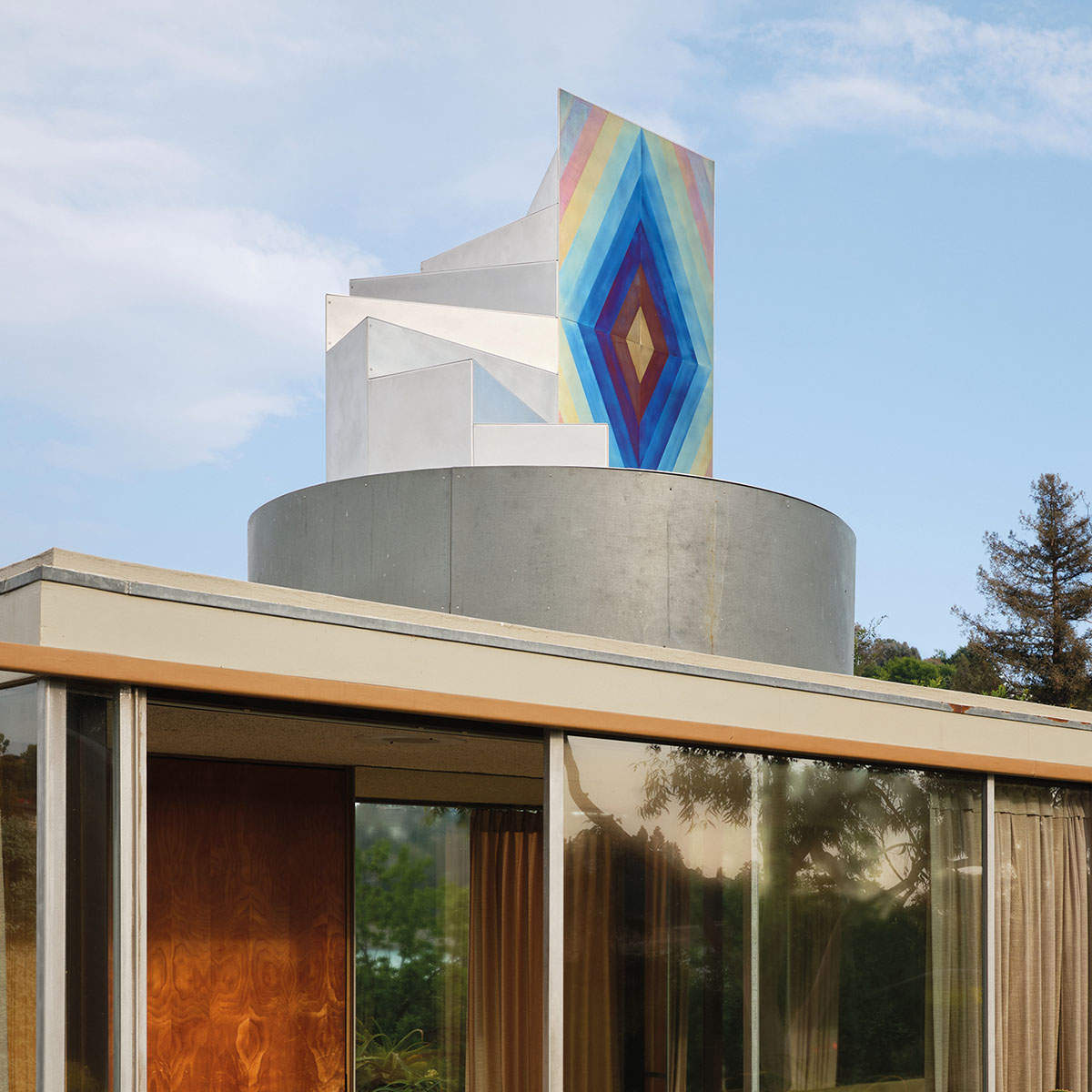
Lastly, as you walk out from the penthouse to the terrace overlooking the Silver Lake Reservoir and look back, there is another work on the rooftop, InFinial.
It is a sculpture in the form of a spiraling staircase, made of aluminum, and it terminates in four anodized titanium panels that mirror one another to form a diamond shape. The process of anodizing titanium involves running electricity through the metal. It changes the physical structure of the titanium so it reflects light differently, which is why we see different colors. For example, 10 volts will make it appear gold, 20 volts will turn it purple, etc. I used ten stops on each panel, ranging from 10 to 100 volts. No pigment is involved in this process, only electricity. I like it a lot, as the whole exhibition – and the VDL House – is about reflections. Also, the work faces west, toward the reservoir, where you often have the most amazing sunset scenarios, with skies full of orange, pink, purple, and light blue. So in a way, It seems as if the work reflects the sky though the color comes from within the material.
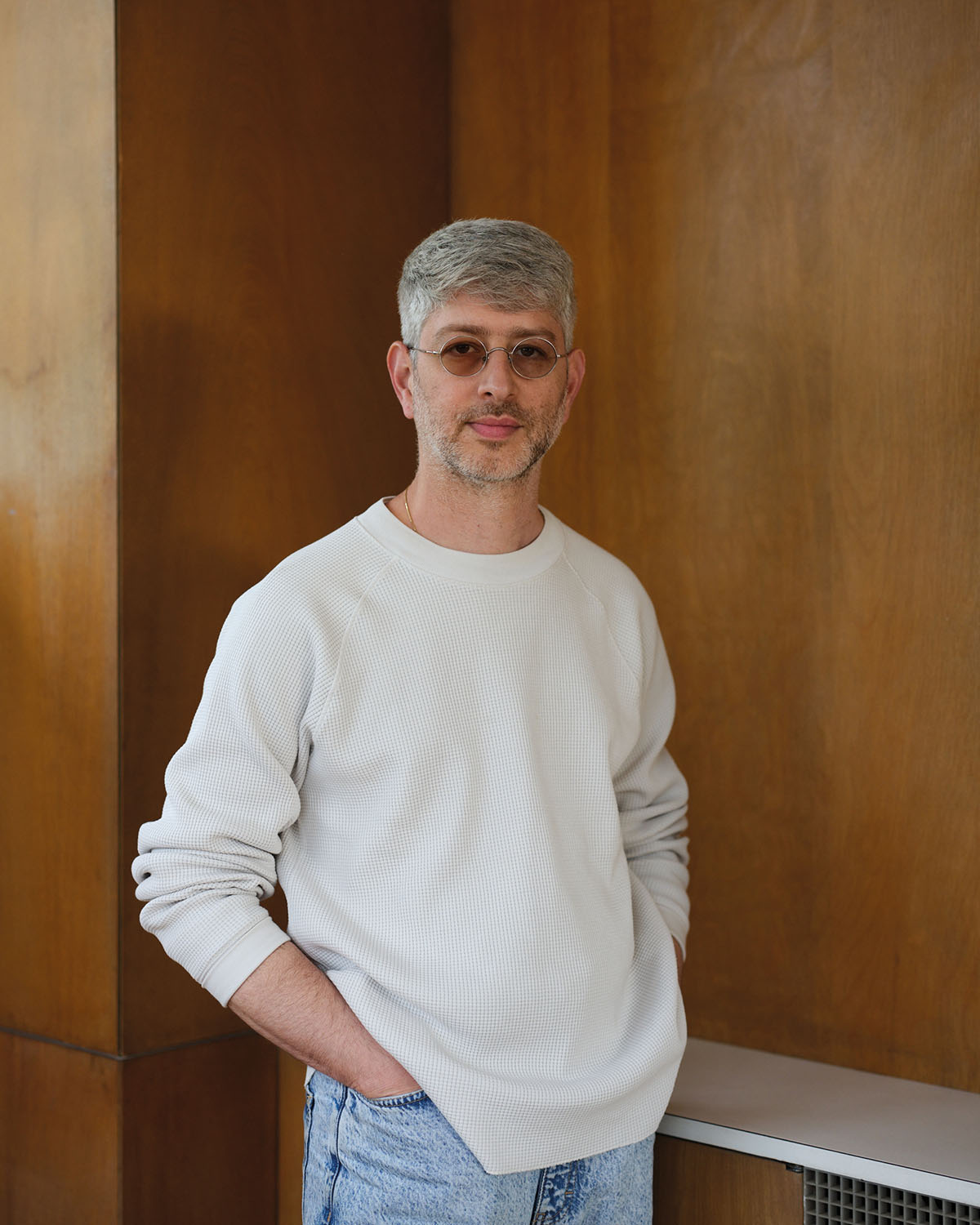
The cylinder on the rooftop is an iconic part of the building. You see it from everywhere, like a crown, and now, it has become a sort of base for my work. A finial in architecture is a decorative ornament typically placed at the top of a roof, spire, gable, or other vertical element to mark the apex or to close a form. I chose the title InFinial, as it marks the idea that there is no peak, no clear border, only an open end, a continuum.
Maayan Elyakim – www.maayanelyakim.com
Dan Handel – www.instagram.com/danhandel
Neutra VDL House – www.neutra-vdl.org
Noam Saragosti – www.instagram.com/noamsaragosti
Lital Megidish – www.instagram.com/litalmegidish
Maayan Elyakim is a multidisciplinary artist working across a broad spectrum of artistic media. His practice is rooted in a cosmological approach, with each piece forming a self-contained link in a reimagined (a)historical continuum. His work explores the potential of functional objects and the built environment—those most defined and literal aspects of daily life—to reveal possibilities that evoke abstract, emotional, and spiritual experiences. Driven by a deep engagement with material processes and symbolic systems, his practice reflects a lifelong dedication to mastering techniques from diverse artistic and craft traditions, combined with in-depth research of realms such as art history, the sciences, and mythology.





